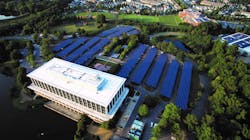What You Should Know About Microgrids
One of the primary content categories on EnergyTech’s menu bar is Microgrids, but how familiar are you with these decentralized power sources?
To provide some clarity, EnergyTech has turned to microgrid specialist Mark Feasel, president of Smart Grid North America with Schneider Electric. Read on for Feasel’s perspective on why business owners are increasingly deploying microgrids, what they should consider when choosing a microgrid, details about operations and maintenance, and more.
EnergyTech: Extreme weather events such as major hurricanes and deep freezes are nothing new. Traditionally, what options have large commercial and industrial energy users had to avoid or limit the impact of such events on their business operations?
Mark Feasel: Traditionally, large commercial and industrial energy users have had to avoid operating at a large scale during extreme weather events, such as major hurricanes or deep freezes. These conditions often cause power outages for hours, days or even weeks at a time, which derail production, shipping, and ultimately impact the success rate of the user. To avoid or limit the impact on their business operations, companies have turned to generators as a back-up power source. There are multiple types of generators that a company may use, but about 95% percent of generators run on diesel or gas. The size and specific type will depend on the total watts of power needed to keep the power on and length of time you need it. While useful for a short period of time, these kinds of generators aren’t economical or sustainable for long-term use.
ET: How long have microgrids been a viable option? Technically and economically, how are microgrids becoming a more attractive alternative for large business owners?
Feasel: Microgrids have been a viable option for longer than most realize. They have been a part of our energy history for centuries but haven’t always been called “microgrids.” The first microgrid is technically dated back to 1882 when Thomas Edison first combined heat and power, producing electricity and thermal energy at Pearl Street Station (in New York City). Microgrids have been adapted and used in a variety of forms since then, most commonly at universities and campuses. Other early adopters of microgrids included hospitals, data centers, manufacturing plants, and other facilities where reliability and resiliency are essential. Microgrids have more recently come to the forefront of the energy industry since the disastrous Superstorm Sandy showcased the importance and reliability of microgrids during a major natural disaster.
Today, organizations of all kinds are turning to microgrids and distributed energy resources as the more attractive alternative with the provided sustainability and financial benefits.
In terms of sustainability the value of microgrids means that resiliency can be diversified. Instead of using generators, microgrids can use cleaner and greener types of distributed energy resources. This can include solar PV, combined heat and power, wind, and battery storage to ensure resiliency at a site.
Costs can vary as microgrids range dramatically in size and complexity, but businesses are able to take advantage of the energy-as-a-service (EaaS) approach to eliminate upfront costs. Similar to a software-as-a-service model, with EaaS you avoid capital expenditures and instead pay only for ongoing service. Microgrids in return keep facility power on during grid outages, store electricity and sell it back to the grid during peak demand, and integrate on-site renewables such as wind and solar.
ET: What are the primary microgrid options available to commercial and industrial energy users?
Feasel: There are three primary microgrid options available: grid-tied, which is reliant on the grid at all times; islandable, which transitions between grid and own microgrid; or off-grid, where you are solely reliant on yourself. But first, you need to decide if a microgrid is right for you. Microgrids are not for everybody, but they can be an intelligent and powerful addition to your energy system. Important considerations to be made include:
- if energy use is high
- you are considering adding a solar installation
- power is unreliable
- your region offers attractive incentives for greater renewable energy use or on-site generation
- you want greater control over your energy future
- or energy resilience is critical to your business.
Some prime microgrid candidates typically include corporate campuses, data centers, hospitals, manufacturing plants, colleges, military bases, ports, and others.
The next step is determining if microgrids will be feasible for you. A typical project lead time is over a month and includes site visits, manager interviews, overview of site plan and data, utility bill and tariff analysis. Understanding deliverables and ultimate goals in this phase is key. After reviewing everything, energy teams can help determine if the project is feasible and what the timeframe would look like.
From there you then want to understand how you would fund the microgrid. There are two options to utilize: energy-as-a-service or capex. Energy-as-a-service, also known as EaaS, gives customers access to energy management services without upfront costs. Similar to a software-as-a-service model, with EaaS, you avoid capital expenditures like equipment costs and maintenance and pay only for ongoing service. Capital expenditures (capex) refers to the traditional money an organization or corporate entity spends to buy, maintain, or improve its fixed assets.
ET: What are key considerations when deciding which type of microgrid to invest in? Also, what should a business owner know regarding microgrid operation and maintenance needs?
Feasel: When considering what type of microgrid to invest in, it’s important to weigh budgets, location of the sites, the size of the facility, current reliance on the grid, and overall energy needs. Any organization seeking to gain control over energy costs, advance sustainability, and increase resiliency can benefit from a microgrid. Some companies prefer to build their own, but it is important to assess the situation and have an expert talk through your project needs before investing. Microgrids operate 24/7, 365 days a year. It’s key to find a microgrid that can easily integrate into your operating system and has ready-to-use tools to do so.
One example of this is Schneider Electric’s new energy tools, which serve as part of its EcoStruxure Platform: EcoStruxure Microgrid Build, and EcoStruxure Microgrid Advisor. This end-to-end digital architecture combines best-in-class Internet of Things (IoT) and tech to enable connectivity, intelligence, and smart operations to drive sustainability. These tools utilize advanced algorithms to provide real-time intelligence, insights, and access to available power sources and loads to control and optimize various energy resources based on monitoring operating conditions and maximizing economic return. This technology enables organizations across government, medical, retail, education, business, and hospitality, among other industries, to invest in becoming less dependent on a traditional power grid—the strained and failing infrastructure currently underpinning our nation.
Through EcoStruxure Microgrid Build, a web-based configuration design tool that helps to create, control, and design the microgrid, the systems can be configured in a simple and easy-to-use manner that reduces human error and lowers engineering costs and time. Meanwhile, EcoStruxure Microgrid Advisor can create an optimized microgrid through advanced forecast algorithms to maximize revenues from distributed energy resources, optimize energy consumption, curtail carbon emissions, and ensure power reliability from the onsite generation assets. These two solutions work in tandem to protect small to medium-sized entities from unexpected power outages, enable better energy management, reduce energy costs, and contribute toward sustainable development.
Maintenance and services typically depend on the assets on site. Needs will vary depending on size and needs. Utilizing Energy as a Service helps in handling all these needs, working with trusted partners like AlphaStruxure and GreenStruxure.
ET: What are some common misconceptions about microgrids?
Feasel: One common misconception is that microgrids are too expensive. Microgrids are more cost-efficient than ever before, especially with financing options like energy-as-a-service. The reduction of power outages alone provides major cost benefits, especially when dealing with critical loads. When power goes out, that means business operations can no longer function thus money is lost. Microgrids help businesses avoid those losses. They also provide additional cost savings by storing electricity and selling it back to the grid during peak demand time.
Another common misconception is microgrids are only useful during extreme weather situations and power outages. Microgrids do more than provide a sense of relief that you have power during an outage as they co-locate electricity generation and consumption. Unlike the utility grid, which generates electricity in a centralized power plant and then distributes it along hundreds of miles of transmission lines, a microgrid generates electricity on-site. Intelligent software controls can then automatically switch the facility between the utility grid and the microgrid based on factors such as power reliability and cost efficiency. When electricity prices peak, microgrids respond. They also provide sustainable benefits and clean energy to aid in the overall decarbonization efforts encouraged in today’s modern world.
ET: Would you like to add any comments about microgrid technology?
Feasel: As solar continues to be a growing part of the energy conversation, microgrids are a critical component in supporting new solar requirements. Microgrids (solar + battery storage) are an essential component of end-to-end IoT systems for sustainable buildings. Microgrids can reduce our carbon footprint, help minimize risks, increase reliability, reduce energy costs, and even help generate revenue through energy storage. The combination of lower energy storage costs and the price to deploy solar power make microgrids a solution for consumers, businesses, and municipalities to get the most from the energy they consume.
While the use of solar has become more mainstream and is a great step in the right direction, it also needs to be captured correctly. If you’re capturing the energy produced from your solar panels, then the energy is not able to be stored for later use. Storing this energy for later use ultimately builds resiliency and sustainability for the home, office, large-scale commercial buildings, etc. Proper control mechanisms such as edge control is needed to efficiently capture the energy. Easily scalable and modular, microgrids are within reach if solar, battery, and control are in place.
Getting everyone on board for solar, battery, and distributed energy resources is key. Schneider Electric is working to create change beyond C&I facilities, empowering individuals themselves to make a difference and contribute to decarbonizing our world.
About the Author
Rod Walton, EnergyTech Managing Editor
Managing Editor
For EnergyTech editorial inquiries, please contact Managing Editor Rod Walton at [email protected].
Rod Walton has spent 17 years covering the energy industry as a newspaper and trade journalist. He formerly was energy writer and business editor at the Tulsa World. Later, he spent six years covering the electricity power sector for Pennwell and Clarion Events. He joined Endeavor and EnergyTech in November 2021.
Walton earned his Bachelors degree in journalism from the University of Oklahoma. His career stops include the Moore American, Bartlesville Examiner-Enterprise, Wagoner Tribune and Tulsa World.
EnergyTech is focused on the mission critical and large-scale energy users and their sustainability and resiliency goals. These include the commercial and industrial sectors, as well as the military, universities, data centers and microgrids. The C&I sectors together account for close to 30 percent of greenhouse gas emissions in the U.S.
He was named Managing Editor for Microgrid Knowledge and EnergyTech starting July 1, 2023
Many large-scale energy users such as Fortune 500 companies, and mission-critical users such as military bases, universities, healthcare facilities, public safety and data centers, shifting their energy priorities to reach net-zero carbon goals within the coming decades. These include plans for renewable energy power purchase agreements, but also on-site resiliency projects such as microgrids, combined heat and power, rooftop solar, energy storage, digitalization and building efficiency upgrades.

